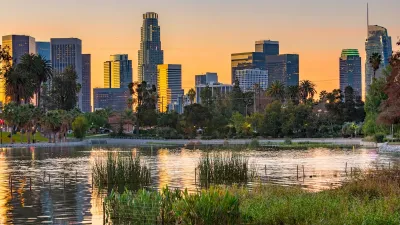The Los Angeles County Department of Parks and Recreation uses GIS technology to identify priority areas for land conservation and restoration as part of its 30x30 plan to fight climate change and protect biodiversity.

In December 2022, the Los Angeles County Board of Supervisors adopted the Parks Needs Assessment Plus (PNA+), which complements and offers information not previously included in the 2016 Los Angeles Countywide Parks and Recreation Needs Assessment (PNA). Specifically, PNA+ contains data and analyses in support of expanding land conservation and restoration, improving transit to parks, and other strategies to meet regional and rural recreation needs, especially in the county's most vulnerable communities.
In this article, Sunny Fleming and Sophia Garcia discuss how the L.A. County Department of Parks and Recreation (DPR) used GIS technology as part of the PNA+ to: 1) identify priority areas for conservation and restoration; 2) assess the needs of rural residents who live near open land but have few recreational amenities; and 3) support a strategy of remediating degraded lands in underserved neighborhoods.
The PNA+ is L.A. County's 30x30 strategy which is equity-focused and aligns with state and federal goals to conserve 30 percent of lands and coastal waters by the year 2030 to fight climate change and protect biodiversity. PNA+ addresses both environmental conservation and restoration. It identifies priority areas for environmental conservation which are areas that offer the most environmental benefits as measured by species diversity, significant habitat, habitat connectivity, proximity to a waterbody, and habitat type.
The study also calls out priority areas for environmental restoration. These are areas that have the most environmental burdens with respect to groundwater threat, hazardous waste, poor air and water quality, and pollution burden. Examples include oil fields, brownfields, landfills, and other degraded lands which may be converted to parks and open space in the future. The restoration of degraded lands is of great importance and a matter of environmental justice in L.A. County where numerous underserved communities are plagued with environmental burdens.
FULL STORY: Los Angeles County Maps Equitable Access to Nature, Remediates Degraded Lands

Alabama: Trump Terminates Settlements for Black Communities Harmed By Raw Sewage
Trump deemed the landmark civil rights agreement “illegal DEI and environmental justice policy.”

Planetizen Federal Action Tracker
A weekly monitor of how Trump’s orders and actions are impacting planners and planning in America.

The 120 Year Old Tiny Home Villages That Sheltered San Francisco’s Earthquake Refugees
More than a century ago, San Francisco mobilized to house thousands of residents displaced by the 1906 earthquake. Could their strategy offer a model for the present?

Ken Jennings Launches Transit Web Series
The Jeopardy champ wants you to ride public transit.

BLM To Rescind Public Lands Rule
The change will downgrade conservation, once again putting federal land at risk for mining and other extractive uses.

Indy Neighborhood Group Builds Temporary Multi-Use Path
Community members, aided in part by funding from the city, repurposed a vehicle lane to create a protected bike and pedestrian path for the summer season.
Urban Design for Planners 1: Software Tools
This six-course series explores essential urban design concepts using open source software and equips planners with the tools they need to participate fully in the urban design process.
Planning for Universal Design
Learn the tools for implementing Universal Design in planning regulations.
Clanton & Associates, Inc.
Jessamine County Fiscal Court
Institute for Housing and Urban Development Studies (IHS)
City of Grandview
Harvard GSD Executive Education
Toledo-Lucas County Plan Commissions
Salt Lake City
NYU Wagner Graduate School of Public Service





























